Archived Article Detail
By Thomas P. Moore
WHAT’S NEW IN THE MINERAL WORLD ARCHIVE – posted on 3/16/2009
March 16, 2009
The 2009 Tucson Show has come and gone, and I’ve finished writing the show report for the forthcoming May-June issue (for me, the real finish line to be crossed each late-February). We’re heading into a time of the year when the big shows take a break, spring gathers its firepower (with a tumultuous-sweet smell from the new buds on the orange tree in my front yard), and field-collecting beckons to whomever has opportunity and inclination. A few major dealers have already posted news of their coups from the Show, and I’ll mention a couple of these offerings in such a way as not to steal thunder from my future report in the magazine, and I’ll pass on some miscellaneous other news also. So here comes a bit of spring-fresh intelligence concerning things…
On The Web
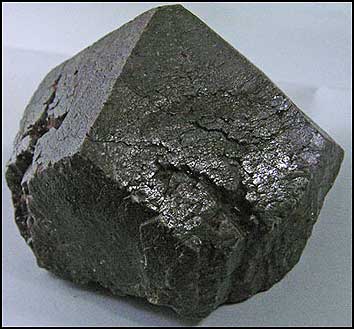
AA Mineral Specimens specimen and photo.
At the Tucson Show, Rob Lavinsky gave me a peek at a single extraordinary loose crystal of zircon, about 10 cm across, which he’d just acquired; he said that only a few such crystals had come out so far from a very new find at an undisclosed place in Malawi (not Mount Malosa). Thus I was not too surprised to come on a picture of another such zircon crystal in a recent update to the website of the Australian dealership AA Mineral Specimens (www.aamineralspecimens.com). That dealership said that the crystals are coming from the “Rift Mineral Province, Malawi.” In time, presumably, we’ll get specifics about the locality, but meanwhile we can note that Malawi, a pea-pod-shaped little country, lies just on the western edge of the Great Rift Valley of Africa, one of whose manifestations is Lake Malawi, which borders the pea pod on its east. According to an article (found on the web) on Malawian geology, the East African rift zone is widely characterized by intrusions of complex nepheline syenites, and alkaline igneous rocks like these are indeed often hospitable to zircon, as at Mount Malosa in southern Malawi. Anyway, these are exceptional zircon crystals for their size alone: the loose singles offered by AA Mineral Specimens measure from 3.5 to 9 cm across. Opaque chocolate-brown, sharp-edged, and even fairly lustrous, these are actually composite crystals, with intricate patterns of little square “steps” and square-outlined surface pits giving sign of individual crystal domains. They are slightly radioactive, and they are strongly fluorescent orange in shortwave ultraviolet light.
Rob Lavinsky’s The Arkenstone (www.irocks.com) has, as usual, many fine new things to offer, of which the juiciest (in my opinion) are about a dozen specimens of ruby corundum from a digging site near the village of Winza, Mpwapwa district, Dodoma Region, Tanzania. This occurrence was discovered in early 2008, and a “ruby rush” immediately ensued. Now, about a year later, 5,000 Tanzanian miners are working in pits in eluvial soil, and several shafts (to 30 meters deep) have reached bedrock. Most of the crystals recovered thus far have been found as floaters in the eluvium. The corundum crystals range in size to 2.5 cm or so; they are rhombohedrons, hexagonal prisms and combinations of the two forms. At their best the crystals are vibrant red and wholly gemmy; many are color-zoned in red and purplish blue, and some of the red crystals have tints of orange (after a certain threshold of orange coloration is reached, the gem trade calls them “orange-red sapphire” or “fancy sapphire”). Originally the crystals were enclosed in a peculiar, coarse-grained, bluish green igneous rock consisting largely of amphiboles, pyroxenes, and talc—Rob’s matrix pieces thus look very different from familiar Burmese, Vietnamese and Pakistani ruby specimens, with their matrix of “dirty” white marble. Some of the Winza rubies show inclusions of amphibole (?), as thin-acicular crystals which form long curves, or even circles, in the red gemmy interiors. (Much of the “background” information presented here comes from an extensive write-up posted by Swiss mineralogists and gemologists on www.gemresearch.com: we can expect to learn more as research proceeds, especially as regards the deposit’s geological nature, which is not yet fully understood.) The three pictures, below, of Arkenstone specimens suggest the range of what is available now on that site. The specimens’ prices are all in the low three figures: remember that we are talking about serious gem-potential material, and Rob already has had to put in some hard work to see that at least a few specimens evade the clutches of the gem merchants and cutters.
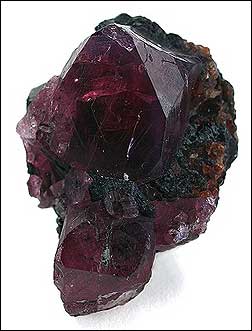
Arkenstone specimen and photo.
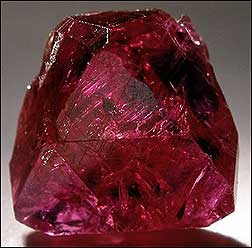
Arkenstone specimen and photo.
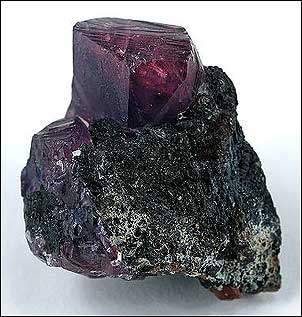
Arkenstone specimen and photo.
No major mineral show feels quite right until one espies John Veevaert bouncing about—greeting friends, taking pictures and videos for his online report, selling specimens by the bye, helping me gather photos for my report, and, of course, picking up first-rate stock to sell on his Trinity Minerals (www.trinityminerals.com) site. Here I’ll recommend three items now to be seen—at prices which I think are quite low, in general, for such nice things—on that site. First, John offers a few matrix specimens, 1.5 to 5.8 cm across, showing sprinklings or coatings of microcrystals of rheniite—ReS2—from the Kudravy Volcano, Iturup Island, Kuril Island Arc, Russia. (Actually let me presume to correct John’s labels: he says “Kurill Island,” but in fact the volcano is on Iturup Island, one of the Kuril Islands which stretch from Hokkaido Island, Japan, to Russia’s Kamchatka Peninsula, in the north Pacific.) Rheniite is the only known mineral containing essential rhenium. For ten years following 1994—the year in which specimens were (first?) collected—a few Russian dealers who brought the material to market called it simply “rhenium sulfide,” but in 2004 the name “rheniite” was approved by the IMA. The brilliant metallic black, commonly iridescent rheniite microcrystals formed by gas sublimation on porous gray tuff around a volcanic vent; some specimens were collected soon afterwards, but when, a bit later, the collector returned, he found that a further rise in the temperature had caused all of the rest of the rheniite to vaporize. Hence John’s specimens are 14 years old, and it’s probable that no more will appear unless, of course, the geothermal phenomenon is repeated, and someone knowledgeable happens by Kudravy Volcano again. The best of the Trinity Minerals specimens are quite attractive, with bright, oil-slick-like iridescence flashing out from the thicker coatings of rheniite crystals over the matrix (which itself, however, resembles dirty cement).
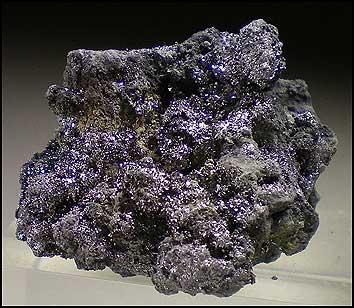
Trinity Minerals specimen; John Veevaert photo.
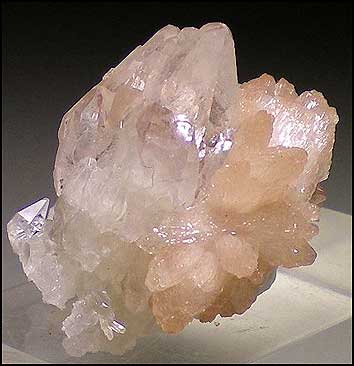
Cape Province, South Africa. Trinity Minerals specimen; John Veevaert photo.
The newly described species olmiite, specimens of which were once thought to be poldervaartite, caused a big stir at last fall’s Munich Show, when some South Africans brought in numerous beautiful specimens from a recent strike by Paul Balayer in the N’Chwaning II mine near Kuruman, Northern Cape Province, South Africa: for a fuller story, plus some pretty pictures, see my Munich report in January-February 2009. Paul Balayer came to Tucson, too, with fine olmiite specimens from the same strike, but he arrived late, and our paths didn’t cross, so I missed seeing and writing about the pieces which John Veevaert meanwhile scooped up. What distinguishes these from most of the Munich specimens is that the lustrous, pale-peach-colored, spherical aggregates of olmiite are associated with big, sharp, beautiful, scalenohedral crystals of milky white to transparent and colorless calcite, in crystals reaching 6 cm long. The dramatic olmiite/calcite combination specimen shown here is typical of about 25 specimens, thumbnail to small-cabinet size, now awaiting you on the Trinity Minerals site.
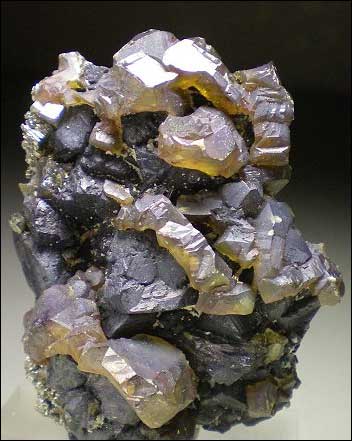
Department, Peru. Trinity Minerals specimen; John Veevaert photo.
And John Veevaert picked up from Jaroslav Hyršl in Tucson just three large-miniature specimens of sphalerite from a new find in the Ticlio mine, Morococha district, Junin Department, Peru. Each piece shows two generations of sphalerite crystals, the earlier crystals dark, submetallic and brown, the later ones (poorer in iron) a beautiful transparent yellow-green. Small crystals of galena and chalcopyrite are present as well, and on one of John’s specimens the sphalerite crystals rest on a substrate of drusy quartz.
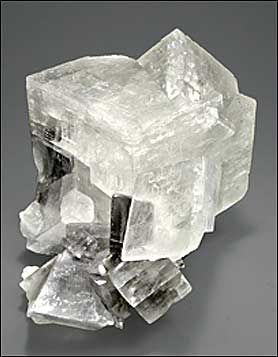
Fabre Minerals specimen; Jordi Fabre photo.
To quote from knowledgeable Spanish dealer Jordi Fabre, “The Eugui quarry in Navarra [Spain] is famous for its specimens of…dolomite. While the quarry is still active, specimens are only found from time to time. In 1997-1998 a significant number were found and over the last few years a few more have appeared.” It is nice to know that this place in northern Spain’s Basque country has not yet finished producing (when the mood seizes it) what are unquestionably, at their best, the finest dolomite specimens in the world. (See our article on this famous locality in the March-April 1991 issue.) On his site (www.fabreminerals.com), Jordi now offers six choice Eugui dolomites, three of them collected in 1997 and three collected in 2007. Ranging in overall size between 5.5 and 12.5 cm, the crystal groups sport razor-sharp dolomite rhombohedrons to 5 cm on edge, some transparent and nearly colorless, others milky gray-white. Also from Eugui there is a 9.7-cm spray of translucent brown aragonite crystals, and there is a 4.7-cm white matrix on which sits up, very smartly, a sharp, bright green, 2.2-cm crystal of chalcopyrite coated with malachite: such chalcopyrite specimens are another, much less well known specialty of the locality.
A March 10 update to Dan Weinrich’s website (www.danweinrich.com) displays some very aesthetic specimens from new finds in the “Kunene region,” Namibia. Dan is probably wise to denote the locality vaguely like that, as several specimen-rich copper prospects exist around Kunene, in the Kaokoveld region of northern Namibia. The new specimens may come from the Omaue prospect but are more likely to come from more recently developed diggings near the tiny settlement of Kandesei (see my note on shattuckite, and these “Kunene region” locality snarls, in the May 2008 installment of this column). Dan’s new shattuckite specimens already seem familiar, as some like them showed up with a few dealers at the Tucson Show just past. These are fragile specimens consisting of detached crusts of sky-blue shattuckite botryoids: some have deep green sprays of “primary” malachite in association; others have spottings of lustrous green dioptase crystals; in still others, shattuckite travels alone. The malachite specimens on Dan’s site are single fans and irregular clusters of fans of densely packed acicular crystals, opaque pale green and slightly chatoyant, the specimens ranging in size from 3 to almost 9 cm. Completely new (at least to me) are the Kunene cerussite specimens: loose, thumbnail-size V-twins (and one 3.7-cm cluster of several twins), the cerussite being a pleasant translucent smoky brown.
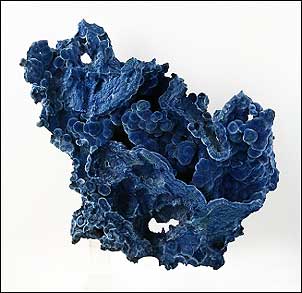
Dan Weinrich specimen and photo.
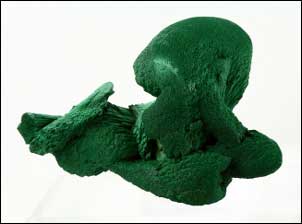
Dan Weinrich specimen and photo.
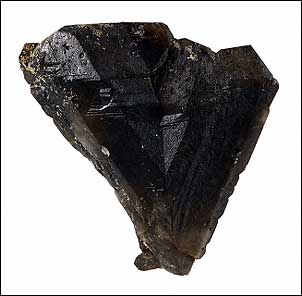
Dan Weinrich specimen and photo.
Isaias Casanova of IC Minerals (www.icminerals.com) has picked up some thumbnail-size St.-Hilaire, Quebec goodies from Frank and Wendy Melanson—part of a hoard, much of it self-collected, that the Melansons began gathering quite a few years ago. Indeed we’ve not seen much St.-Hilaire material quite this exotic: rarities like kupletskite, leucophanite, carletonite, ancylite pseudomorphous after remondite, narsarsukite, elpidite, and others; and very notably there are exquisite little clusters of lustrous, thick (and terminated), transparent pale pink prisms of natrolite. Checking out these thumbnails on the IC Minerals site is great fun, and also you could, of course, apply to the Melansons; their e-mail address is wfmelanson@sympatico.ca.
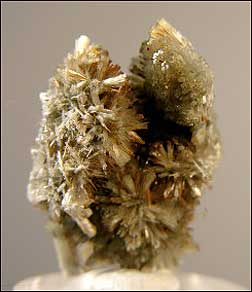
IC Minerals specimen; Isaias Casanova photo.
Richard Ertel of Arrowwood Minerals (www.arrowwoodminerals.com) is running a “Post-Tucson Bulgarian Keystone Sale,” with six generous galleries of Bulgarian minerals, mostly from finds about 10 years ago, all marked at half-price from what were, actually, pretty attractive prices to begin with. Ross Lillie (see next paragraph) goes often to Bulgaria, and he has told me that it’s a very, very hot country these days, mineralogically speaking. Believe it: at major shows, supplies of specimens from the Madan mining district, in the Rhodope Mountains of southern Bulgaria, can seem endless, and prices in general are quite low, especially in view of how very, very good, and (often) how beautiful these crystal groups of galena, sphalerite, manganese-rich calcite, pyrite, chalcopyrite, quartz, etc. can be. On the Arrowwood Minerals site you may peruse excellent miniature and cabinet-size specimens of, among others, galena from the Konski, Krushov Dol, Ninth of September, and South Petrovista mines; sphalerite from the same mines, and from the Ianakiev mine; chalcopyrite from some of the same mines, and from the Mogila mine; rhodochrosite from the Starnica mine; and subtly pretty specimens with two generations of calcite crystals, one white, one latte-colored, from the Droubja mine, Laki district.
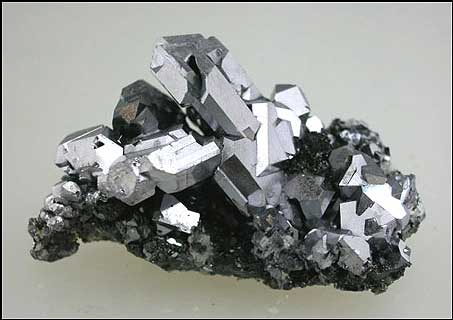
North Star Minerals specimen; Ross Lillie photo.
Ross Lillie’s North Star Minerals (www.northstarminerals.com) has a newly remodeled site, radically more attractive and more user-friendly than formerly. On this site, a March 4 update offers Bulgarian minerals in an array as generous, and almost as bargain-heavy, as that of Arrowwood, and from this array I’ve selected a miniature Kruchev Dol galena specimen—a mass of brilliant, flattened, spinel-twinned crystals—to show you. My point is to affirm that Bulgarian specimens of galena, especially, are world-class, and more generally that we should guard against getting jaded by the Bulgarian bounty—when, someday, it is gone, we shall miss it acutely, respect it immensely, and ask ourselves what has happened to all of it that once was.
A German (and German-language only) site called simply Minerals-net (www.minerals-net.de) has a small selection of very nice miniatures and small cabinet-size specimens of siderite/dolomite/chalcopyrite from Shaft 371, between Niederschlema and Hartenstein, middle Erzgebirge, Obersachsen, Germany. Since the period 1946-1991, when furious exploitation of deep uranium ores took place in the old mines of what was then East Germany, these distinctive specimens have been collected sporadically from extensive dumps around the huge haulage tunnel which was Shaft 371; they emerged in special abundance and quality during the 1980’s, when (it’s a good educated guess) the pieces on this site may have been gathered. Pale brown, lenticular siderite crystals combine with off-white, typically saddle-shaped crystals of dolomite and with sprinkles of tiny, bright chalcopyrite crystals to compose the specimens. The 6.5-cm piece in the picture shown here costs just 20 Euros ( ≈ $25).
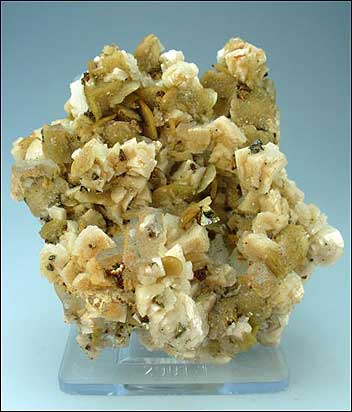
Niederschlema-Hartenstein, Obersachsen, Germany.
Minerals-net.de specimen and photo.
A new site just now coming up on the web promises to bring us interesting batches of miscellaneous, mostly high-end specimens during the coming months and years. The dealership, Mineral Masterpiece (www.mineralmasterpiece.com), is a partnership between connoisseur collector Irv Brown and young Tom Spann, son of Jim and Gail Spann. Jim and Gail are a couple from Texas who, though they have been collectors for only about four years, already possess a crowded houseful of superb worldwide mineral specimens (see pictures of some of these in our recent Private Mineral Collections in Texas supplement). Mineral Masterpiece bears watching if only because it is kicking off by selling some specimens from the senior Spanns’ collection and from Irv Brown’s collection; at present only a few specimens are advertised, as site construction is not yet finished, but here’s wishing Tom and Irv every success. I met Tom for the first time during the 2009 Tucson Show, and his youth + enthusiasm + already attained expertise add up to a good harbinger for the future of serious mineral collecting, yes even after all of us “elders” are gone.
Other News
First, don’t forget Dave Waisman’s new “Houston Fine Mineral Show,” to be held May 1–3, 2009 in the Embassy Suites Hotel, 2911 Sage Rd., Houston, Texas. This show is a successor to the one which debuted last May in Dallas (see my report in July-August 2008), and it should be a civilized event of the same sort: a fairly small number of high-end dealers in a deluxe hotel environment, selling their best. Admission is free, and the great collection of the Houston Museum of Natural Science is nearby, and Dave hopes to draw somewhat bigger crowds in this new venue than showed up in Dallas last year. For more information, go to www.FineMineralShow.com.
Frequently the Mineralogical Record gets calls from people asking about prices, availabilities, and possible resale values of old issues of our magazine. Let me make a few things clear here, and maybe save some readers a phone call: no, we do not buy old issues back, but yes, on the other hand, we do sell copies of issues which are still in print (just go to the Back Issues section of this website), and yes, you may, if you are persistent, find dealers who sell even out-of-print issues. Sharon Cisneros at Mineralogical Research Company (www.minresco.com) has been one such long-time supplier. Right now, on the site of 10x Minerals (www.10xminerals.com), there’s a special offer of many back issues at “20% off for limited time”: this offer features complete volume sets (i.e. with out-of-print issues included) for volume 1 through volume 18, for prices from $85 (vol. 9) through $355 (vol. 7, including the coveted “Colorado I”). You may also procure copies of some rare issues such as “Tsumeb” (vol. 8, no. 3– $50), “Gold I” (vol. 13 no. 6– $60), and the special-insert Houston Museum Supplement (vol. 23 no. 1– $15). And here’s a good place to give some good advice: do not throw your old issues away, for besides the abundance of mineralogical information and lore they contain and preserve, they are apt, in time, to turn into collectors’ items in their own rights, and as such to be worth some not insignificant monies (especially if you keep them in good condition).
Finally, Isaias Casanova has alerted me to a new web-based organization for thumbnail collectors (I wonder why he thought of me particularly…). The bulletin which Larry Rush of Connecticut sent Isaias runs as follows: “Thumbnail Collectors! Any mineral collector who enjoys thumbnail-size specimens may be interested in a new collectors’ internet group devoted to thumbnails. We have organized a group and established a web site oriented towards the education, buying, selling and trading of just thumbnails. There are no fees or dues, just an interest in collecting thumbnails and sharing of that interest with other members all over the world. For more information, see our website at www.thumbnails.crocoite.com, or contact Larry Rush at larryrush@att.net.”
And that’s a wrap. Until next installment…
For questions about this column, please email Tom Moore.
